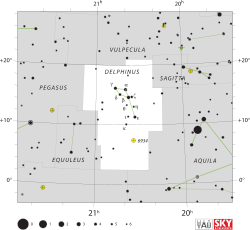Star in the constellation Delphinus
Eta Delphini , Latinized from η Delphini, is a candidate astrometric binary star system in the northern constellation of Delphinus . It has an apparent magnitude of about 5.4, meaning that it is faintly visible to the naked eye. Based upon a parallax measurement of 13.81 mas made by the Hipparcos spacecraft , this star is around 240 light years away from the Sun. It is advancing in general direction of the Earth with a radial velocity of −25 km/s.
The stellar classification of the visible component is A3 IVs, which matches an A-type subgiant star with narrow absorption lines . It is a suspected chemically peculiar star that is about 64.3%±9.2% of the way through its main sequence lifetime. SIMBAD lists this star as a variable star , although it is not catalogued as such in the GCVS . It has more than double the mass and radius of the Sun, and is radiating 35 times the Sun's luminosity from its photosphere at an effective temperature of around 9,355 K.
References
^ van Leeuwen, F. (2007), "Validation of the new Hipparcos reduction", Astronomy and Astrophysics , 474 (2): 653–664, arXiv :0708.1752 , Bibcode :2007A&A...474..653V , doi :10.1051/0004-6361:20078357 , S2CID 18759600 .
^ Feinstein, A. (1974), "Photoelectric UBVRI observations of AM stars", Astronomical Journal , 79 : 1290, Bibcode :1974AJ.....79.1290F , doi :10.1086/111675 .
^ Cowley, A.; et al. (April 1969), "A study of the bright A stars. I. A catalogue of spectral classifications", Astronomical Journal , 74 : 375–406, Bibcode :1969AJ.....74..375C , doi :10.1086/110819 .
^ Gontcharov, G. A. (November 2006), "Pulkovo Compilation of Radial Velocities for 35495 Hipparcos stars in a common system", Astronomy Letters , 32 (11): 759–771, arXiv :1606.08053 , Bibcode :2006AstL...32..759G , doi :10.1134/S1063773706110065 , S2CID 119231169 .
^ Anderson, E.; Francis, Ch. (2012), "XHIP: An extended hipparcos compilation", Astronomy Letters , 38 (5): 331, arXiv :1108.4971 , Bibcode :2012AstL...38..331A , doi :10.1134/S1063773712050015 , S2CID 119257644 .
^ David, Trevor J.; Hillenbrand, Lynne A. (2015), "The Ages of Early-Type Stars: Strömgren Photometric Methods Calibrated, Validated, Tested, and Applied to Hosts and Prospective Hosts of Directly Imaged Exoplanets", The Astrophysical Journal , 804 (2): 146, arXiv :1501.03154 , Bibcode :2015ApJ...804..146D , doi :10.1088/0004-637X/804/2/146 , S2CID 33401607 .
^ Pasinetti Fracassini, L. E.; et al. (February 2001), "Catalogue of Apparent Diameters and Absolute Radii of Stars (CADARS)", Astronomy and Astrophysics , 367 (Third ed.): 521–524, arXiv :astro-ph/0012289 , Bibcode :2001A&A...367..521P , doi :10.1051/0004-6361:20000451 , S2CID 425754 .
^ Zorec, J.; Royer, F. (January 2012), "Rotational velocities of A-type stars. IV. Evolution of rotational velocities", Astronomy & Astrophysics , 537 : A120, arXiv :1201.2052 , Bibcode :2012A&A...537A.120Z , doi :10.1051/0004-6361/201117691 , S2CID 55586789 .
^ "eta Del" . SIMBAD Centre de données astronomiques de Strasbourg . Retrieved 2017-08-18.{{cite web }}: CS1 maint: postscript (link )
Eggleton, P. P.; Tokovinin, A. A. (September 2008), "A catalogue of multiplicity among bright stellar systems", Monthly Notices of the Royal Astronomical Society , 389 (2): 869–879, arXiv :0806.2878 , Bibcode :2008MNRAS.389..869E , doi :10.1111/j.1365-2966.2008.13596.x , S2CID 14878976 .
Allen, J. S., "The Classification of Stellar Spectra" , Department of Physics and Astronomy: Astrophysics Group , University College London , retrieved 1 January 2014.
Renson, P.; Manfroid, J. (May 2009), "Catalogue of Ap, HgMn and Am stars" , Astronomy and Astrophysics , 498 (3): 961–966, Bibcode :2009A&A...498..961R , doi :10.1051/0004-6361/200810788 .
Samus, N. N.; et al. (2017), "General Catalogue of Variable Stars", Astronomy Reports , GCVS 5.1, 61 (1): 80–88, Bibcode :2017ARep...61...80S , doi :10.1134/S1063772917010085 , S2CID 125853869 .
Categories :
Text is available under the Creative Commons Attribution-ShareAlike License. Additional terms may apply.
**DISCLAIMER** We are not affiliated with Wikipedia, and Cloudflare.
The information presented on this site is for general informational purposes only and does not constitute medical advice.
You should always have a personal consultation with a healthcare professional before making changes to your diet, medication, or exercise routine.
AI helps with the correspondence in our chat.
We participate in an affiliate program. If you buy something through a link, we may earn a commission 💕
↑
